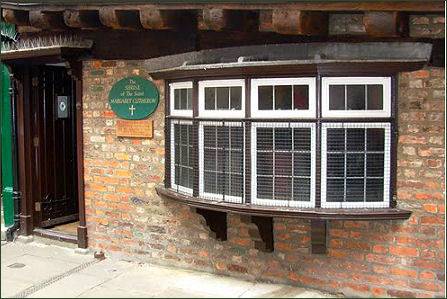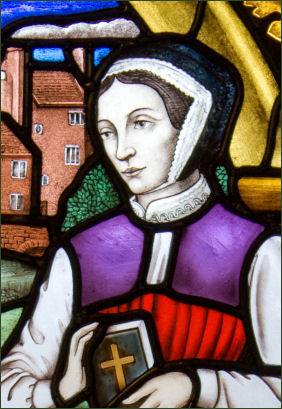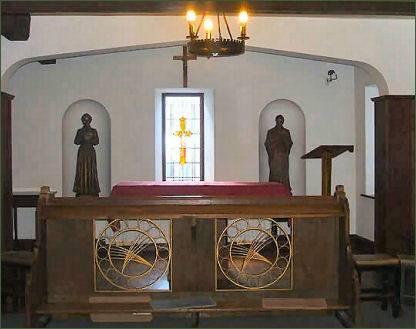St Margaret Clitherow's Shrine

 St. Margaret Clitherow's House and Shrine is located on the Shambles, which with its unique charm, it is one of the most famous streets in Britain. Margaret Clitherow, somtimes referred to as 'the Pearl of York" was crushed to death in Elizabethan times for harbouring Roman Catholic priests.
St. Margaret Clitherow's House and Shrine is located on the Shambles, which with its unique charm, it is one of the most famous streets in Britain. Margaret Clitherow, somtimes referred to as 'the Pearl of York" was crushed to death in Elizabethan times for harbouring Roman Catholic priests.
The small medieval house is located at 35-36 The Shambles and is free to visit. John Clitherow had his butchershop at number 35. However, the street was re-numbered in the eighteenth century, so it is now thought their house was actually on the opposite side of the street. Her home is now a cufflinks shop, Cuffs & Co, and features the priest hole fireplace that ultimately led to her death. A commemorative plaque on the Ouse Bridge marks the site of Margaretís martyrdom.
Saint Margaret Clitherow (1556 Ė 25 March 1586) was born as Margaret Middleton in 1556, she was one of five children of Thomas and Jane Middleton. Her father was a respected businessman, a wax-chandler and a Sheriff of York in 1564. He died when Margaret was fourteen.
At the age of fifteen she married widower John Clitherow, a wealthy butcher and a chamberlain of the city, at St. Martin's church in Coney Street, York on the 8th of July, 1571. Margaret bore him three children. The family lived in the Shambles. Margaret converted to Roman Catholicism in 1574 on the instigation of the wife of Dr Thomas Vavasour, a prominent Catholic in York. Although her husband belonged to the Church of England, he was supportive of his wife as his brother William was a Roman Catholic priest and he paid her fines for non attendance of church services.
She was first imprisoned in 1577 for failing to attend church. Two more incarcerations at York Castle followed, she learned to read Latin while in prison and her third child, William, was born in prison. Margaret risked her life by harbouring and maintaining Catholic priests, she provided two chambers, one adjoining her house and, when her house came under surveillance by the authorities, she rented a house some distance away, where she kept priests hidden and Mass was celebrated through the worst of the persecution of Catholics.
Her home became one of the most important hiding places for fugitive priests in the north of England. Local tradition states that she also housed her clerical guests in the Black Swan Inn at Peaseholme Green, where the Queen's agents were lodged. Many of the priests came from Douai in France but catholics were under persecution in England and Mass was celebrated in secret. Punishment was extreme and a priest could expect a traitorís death if caught. This led to priests moving from location to location to avoid being caught, often placing their lives in the person giving them shelter.
 She sent her older son, Henry, to the English College, relocated in Reims, to train for the priesthood. Her husband was summoned by the authorities to explain why his oldest son had gone abroad, and in March 1586 the Clitherow house was searched. The priest escaped but Margaret and her family refused to speak, however, a frightened Flemish boy revealed the location of the priest hole. Margaret was arrested and called before the York assizes for the crime of harbouring Roman Catholic priests. She refused to plead preventing a trial that would entail her children being made to testify, and being subjected to torture. Though the judges tried in vain to persuade her to renounce her Catholic faith and avoid the death sentence, Clitherow refused.
She sent her older son, Henry, to the English College, relocated in Reims, to train for the priesthood. Her husband was summoned by the authorities to explain why his oldest son had gone abroad, and in March 1586 the Clitherow house was searched. The priest escaped but Margaret and her family refused to speak, however, a frightened Flemish boy revealed the location of the priest hole. Margaret was arrested and called before the York assizes for the crime of harbouring Roman Catholic priests. She refused to plead preventing a trial that would entail her children being made to testify, and being subjected to torture. Though the judges tried in vain to persuade her to renounce her Catholic faith and avoid the death sentence, Clitherow refused.
Although pregnant with her fourth child, Margaret was executed on Lady Day, 1586, in the Toll Booth at Ouse Bridge, by being crushed to death, the standard inducement to force a plea. The two sergeants who should have carried out the execution hired four desperate beggars to do it instead. She was stripped and had a handkerchief tied across her face then laid across a sharp rock the size of a man's fist, the door from her own house was put on top of her and loaded with an immense weight of rocks and stones so that the sharp rock would break her back. Her death occurred within fifteen minutes, but her body was left for six hours before the weight was removed.
Following her execution, Elizabeth I wrote to the citizens of York expressing her horror at the treatment of a woman. Because of her sex, she argued, Clitherow should not have been executed. Margaret Clitherow was beatified in 1929 by Pope Pius XI and canonised on 25 October 1970 by Pope Paul VI among the Forty Martyrs of England and Wales. Their feast day in the current Roman Catholic calendar is 4 May in England and 25 October in Wales. She is also commemorated in England on 30 August, along with martyrs Anne Line and Margaret Ward.
A relic, said to be her hand, is housed in the Bar Convent in York
